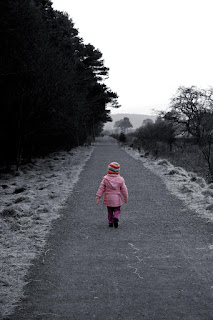 |
| Wandering behavior is common among children with autism. Photo by hotblack at Morguefile.com. |
Elopement behavior in children with autism is both immensely common and extremely stressful for their families, caregivers and teachers According to Pediatrics, 49 percent of parents surveyed reported that their child with an ASD had attempted to elope at least once. Some 26% reported that their child with autism had gone missing long enough to cause concern. A staggering 65% of those children had been in danger of traffic injury during an elopement incident; 24% had been in danger of drowning.
Fortunately, there are plenty of excellent resources available to help families, caregivers, educators and first responders take steps to children with autism from eloping and recover them quickly if they should happen to wander off.
The National Autism Association (NAA) offers both digital and tangible tools to keep kids who wander safe. The NAA Be REDY booklet contains a caregiver checklist, a Family Wandering Emergency Plan, a first responder profile form, a wandering-prevention brochure, a sample IEP letter, a student profile form, emotion identification cards and wandering quick tips.
NAA offers a free Big Red Safety Box to families affected by autism. The Big Red Safety Box includes a copy of the Be REDy booklet, two GE Wireless door/window alarms equipped with batteries, one MedicAlert bracelet or pendant, one shoe tag, five adhesive stop sign visual prompts for doors and windows, two Safety Alert window clings for doors and windows, one red Safety Alert wristband, and one Child ID Kit from the National Center for Missing and Exploited Children.
NAA offers a Big Red Safety Teacher Toolkit to school administrators, teachers or aides who work with students who have autism. The Big Red Safety Teacher Toolkit includes a Be REDy booklet for teachers, four window/door alarms with batteries and five laminated adhesive stop sign visual prompts for doors and windows.
NAA also publishes a Be REDy booklet for first responders. The toolkit contains resources to help first responders prepare for wandering incidents in the communities they serve.
The NAA has a dedicated safety page where you can learn about wandering and elopement, ways to prevent children from engaging in the behaviors and what to do when an incident arises.
The Autism Wandering Awareness Alerts Response and Education (AWAARE) Collaboration is a working group comprised of national non-profit organizations whose mission is to prevent wandering and deaths in the autism community. The member organizations are NAA, the Autism Society of America, AutismOne, Autism Speaks, the Doug Flutie, Jr. Foundation for Autism, the HollyRod Foundation, and Talk About Curing Autism (TACA).
The AWAARE Collaboration provides safety tips, safety resources and recommendations for tracking technology. AWAARE also educates stakeholders about wandering and works on wandering-related policy issues.
Autism Speaks has a page dedicated to wandering, which includes tips for preventing wandering and wandering-related tragedies, steps for preventing wandering at your child's school, and links to wandering-prevention resources for parents and first responders.
The National Center for Missing and Exploited Children (NCMEC) provides information for first responders, as well as tips and resources for parents and community members.


No comments:
Post a Comment